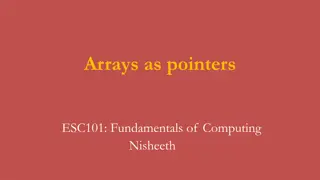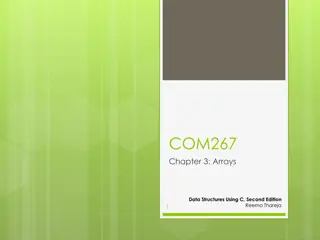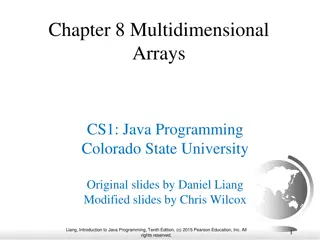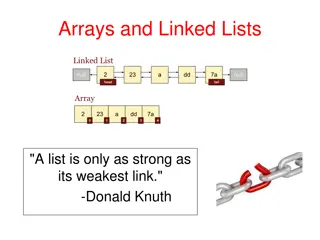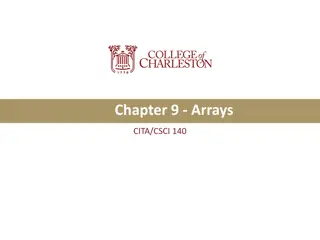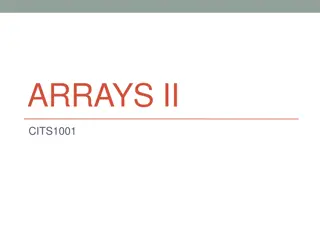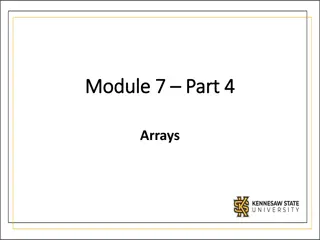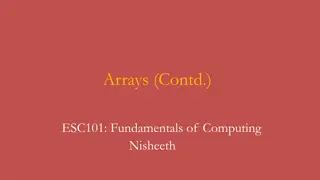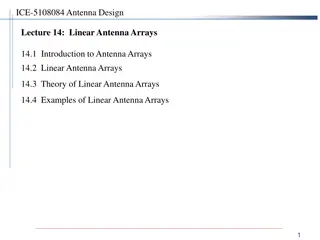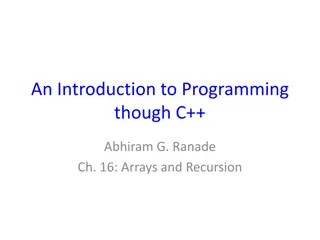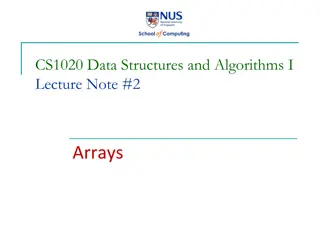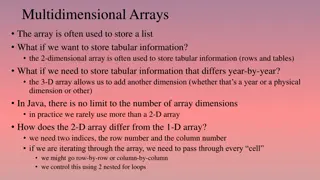
Understanding Control Flow in Computer Organization
Explore the fundamentals of control flow and arrays in computer organization through conditional branch instructions, MIPS architecture, and branch instruction formats. Learn how high-level programming languages handle decision-making and repetition in programs. Discover the essential concepts of making decisions, looping, and traversing arrays that distinguish computers from calculators.
Download Presentation

Please find below an Image/Link to download the presentation.
The content on the website is provided AS IS for your information and personal use only. It may not be sold, licensed, or shared on other websites without obtaining consent from the author. If you encounter any issues during the download, it is possible that the publisher has removed the file from their server.
You are allowed to download the files provided on this website for personal or commercial use, subject to the condition that they are used lawfully. All files are the property of their respective owners.
The content on the website is provided AS IS for your information and personal use only. It may not be sold, licensed, or shared on other websites without obtaining consent from the author.
E N D
Presentation Transcript
Control Flow and Arrays COE 301 Computer Organization Prof. Aiman El-Maleh College of Computer Sciences and Engineering King Fahd University of Petroleum and Minerals [Adapted from slides of Dr. M. Mudawar, COE 301, KFUPM]
Presentation Outline Control Flow: Branch and Jump Instructions Translating If Statements and Boolean Expressions Arrays Load and Store Instructions Translating Loops and Traversing Arrays Addressing Modes Control Flow and Arrays COE 301 KFUPM slide 2
Control Flow High-level programming languages provide constructs: To make decisions in a program: IF-ELSE To repeat the execution of a sequence of instructions: LOOP The ability to make decisions and repeat a sequence of instructions distinguishes a computer from a calculator All computer architectures provide control flow instructions Essential for making decisions and repetitions These are the conditional branch and jump instructions Control Flow and Arrays COE 301 KFUPM slide 3
MIPS Conditional Branch Instructions MIPS compare and branch instructions: if (Rs == Rt) branch to label beq Rs, Rt, label if (Rs != Rt) branch to label bne Rs, Rt, label MIPS compare to zero & branch instructions: Compare to zero is used frequently and implemented efficiently if (Rs < 0) branch to label bltz Rs, label if (Rs > 0) branch to label bgtz Rs, label if (Rs <= 0) branch to label blez Rs, label if (Rs >= 0) branch to label bgez Rs, label beqz and bnez are defined as pseudo-instructions. Control Flow and Arrays COE 301 KFUPM slide 4
Branch Instruction Format Branch Instructions are of the I-type Format: Op6 Rs5 Rt5 16-bit offset Instruction I-Type Format Op=4 Op=5 Op=6 Op=7 Op=1 Op=1 beq Rs, Rt, label bne Rs, Rt, label blez Rs, label bgtz Rs, label bltz Rs, label bgez Rs, label Rs Rs Rs Rs Rs Rs Rt Rt 0 0 0 1 16-bit Offset 16-bit Offset 16-bit Offset 16-bit Offset 16-bit Offset 16-bit Offset The branch instructions modify the PC register only PC-Relative addressing: If (branch is taken) PC = PC + 4 + 4 offset else PC = PC+4 Control Flow and Arrays COE 301 KFUPM slide 5
Unconditional Jump Instruction The unconditional Jump instruction has the following syntax: j label . . . # jump tolabel label: The jump instruction is always taken The Jump instruction is of the J-type format: Op6 = 2 26-bit address The jump instruction modifies the program counter PC: 26-bit address PC4 00 multiple of 4 The upper 4 bits of the PC are unchanged Control Flow and Arrays COE 301 KFUPM slide 6
Translating an IF Statement Consider the following IF statement: if (a == b) c = d + e; else c = d e; Given that a, b, c, d, e are in $t0 $t4 respectively How to translate the above IF statement? bne $t0, $t1, else addu $t2, $t3, $t4 j next else: subu $t2, $t3, $t4 next: . . . Control Flow and Arrays COE 301 KFUPM slide 7
Logical AND Expression Programming languages use short-circuit evaluation If first condition is false, second condition is skipped if (($t1 > 0) && ($t2 < 0)) {$t3++;} # One Possible Translation ... bgtz $t1, L1 # first condition j next # skip if false L1: bltz $t2, L2 # second condition j next # skip if false L2: addiu $t3, $t3, 1 # both are true next: Control Flow and Arrays COE 301 KFUPM slide 8
Better Translation of Logical AND if (($t1 > 0) && ($t2 < 0)) {$t3++;} Allow the program to fall through to second condition !($t1 > 0) is equivalent to ($t1 <= 0) !($t2 < 0) is equivalent to ($t2 >= 0) Number of instructions is reduced from 5 to 3 # Better Translation ... # 1st condition false? blez $t1, next # 2nd condition false? bgez $t2, next addiu $t3, $t3, 1 # both are true next: Control Flow and Arrays COE 301 KFUPM slide 9
Logical OR Expression Short-circuit evaluation for logical OR If first condition is true, second condition is skipped if (($t1 > 0) || ($t2 < 0)) {$t3++;} Use fall-through to keep the code as short as possible # 1st condition true? bgtz $t1, L1 # 2nd condition false? bgez $t2, next L1: addiu $t3, $t3, 1 # increment $t3 next: Control Flow and Arrays COE 301 KFUPM slide 10
Compare Instructions MIPS also provides set less than instructions if (Rs < Rt) Rd = 1 else Rd = 0 slt Rd, Rs, Rt unsigned < sltu Rd, Rs, Rt if (Rs < imm) Rt = 1 else Rt = 0 slti Rt, Rs, imm unsigned < sltiu Rt, Rs, imm Signed / Unsigned comparisons compute different results Given that: $t0 = 1 and $t1 = -1 = 0xffffffff $t2, $t0, $t1 computes slt $t2 = 0 sltu $t2, $t0, $t1 computes $t2 = 1 Control Flow and Arrays COE 301 KFUPM slide 11
Compare Instruction Formats Instruction Meaning Format Rd=(Rs<sRt)?1:0 Rd=(Rs<uRt)?1:0 Rt=(Rs<sim)?1:0 Rt=(Rs<uim)?1:0 slt Rd, Rs, Rt Op=0 Rs Rt Rd 0 0x2a sltu Rd, Rs, Rt Op=0 Rs Rt Rd 0 0x2b slti Rt, Rs, im 0xa Rs Rt 16-bit immediate sltiu Rt, Rs, im 0xb Rs Rt 16-bit immediate The other comparisons are defined as pseudo-instructions: seq, sne, sgt, sgtu, sle, sleu, sge, sgeu Pseudo-Instruction Equivalent MIPS Instructions slt $t2, $t1, $t0 sgt $t2, $t0, $t1 subu $t2, $t0, $t1 sltiu $t2, $t2, 1 seq $t2, $t0, $t1 Control Flow and Arrays COE 301 KFUPM slide 12
Pseudo-Branch Instructions MIPS hardware does NOT provide the following instructions: blt, bltu ble, bleu bgt, bgtu bge, bgeu branch if less than branch if less or equal branch if greater than branch if greater or equal (signed / unsigned) (signed / unsigned) (signed / unsigned) (signed / unsigned) MIPS assembler defines them as pseudo-instructions: Pseudo-Instruction Equivalent MIPS Instructions slt $at, $t0, $t1 bne $at, $zero, label blt $t0, $t1, label slt $at, $t1, $t0 beq $at, $zero, label ble $t0, $t1, label $at ($1) is the assembler temporary register Control Flow and Arrays COE 301 KFUPM slide 13
Using Pseudo-Branch Instructions Translate the IF statement to assembly language $t1 and $t2 values are unsigned bgtu $t1, $t2, L1 move $t3, $t4 L1: if($t1 <= $t2) { $t3 = $t4; } $t3, $t4, and $t5 values are signed bgt $t3, $t4, L1 blt $t4, $t5, L1 addu $t3, $t4, $t5 L1: if (($t3 <= $t4) && ($t4 >= $t5)) { $t3 = $t4 + $t5; } Control Flow and Arrays COE 301 KFUPM slide 14
Conditional Move Instructions Instruction Meaning R-Type Format movz Rd, Rs, Rt if (Rt==0) Rd=Rs Op=0 Rs Rt Rd 0 0xa movn Rd, Rs, Rt if (Rt!=0) Rd=Rs Op=0 Rs Rt Rd 0 0xb if ($t0 == 0) {$t1=$t2+$t3;} else {$t1=$t2-$t3;} addu $t1, $t2, $t3 bne $t0, $0, L1 addu $t1, $t2, $t3 j L2 L1: subu $t1, $t2, $t3 L2: . . . subu $t4, $t2, $t3 movn $t1, $t4, $t0 . . . Conditional move can eliminate branch & jump instructions Control Flow and Arrays COE 301 KFUPM slide 15
Next . . . Control Flow: Branch and Jump Instructions Translating If Statements and Boolean Expressions Arrays Load and Store Instructions Translating Loops and Traversing Arrays Addressing Modes Control Flow and Arrays COE 301 KFUPM slide 16
Arrays In a high-level programming language, an array is a homogeneous data structure with the following properties: All array elements are of the same type and size Once an array is allocated, its size cannot be modified The base address is the address of the first array element The array elements can be indexed The address of any array element can be computed In assembly language, an array is just a block of memory In fact, all objects are simply blocks of memory The memory block can be allocated statically or dynamically Control Flow and Arrays COE 301 KFUPM slide 17
Static Array Allocation An array can be allocated statically in the data segment A data definition statement allocates static memory: label: .type value0 [, value1 ...] label: is the name of the array .type directive specifies the size of each array element value0, value1 ... specify a list of initial values Examples of static array definitions: arr1: .half 20, -1 # array of 2 half words arr2: .word 1:5 # array of 5 words (value=1) arr3: .space 20 # array of 20 bytes str1: .asciiz "Null-terminated string" Control Flow and Arrays COE 301 KFUPM slide 18
Watching Values in the Data Segment The labels window is the symbol table Shows labels and corresponding addresses The la pseudo-instruction loads the address of any label into a register Control Flow and Arrays COE 301 KFUPM slide 19
Dynamic Memory Allocation One of the functions of the OS is to manage memory A program can allocate memory on the heap at runtime The heap is part of the data segment that can grow at runtime The program makes a system call ($v0=9) to allocate memory .text . . . li $a0, 100 # $a0 = number of bytes to allocate li $v0, 9 # system call 9 syscall # allocate 100 bytes on the heap move $t0, $v0 # $t0 = address of allocated block . . . Control Flow and Arrays COE 301 KFUPM slide 20
Allocating Dynamic Memory on the Heap 0x7fffffff Stack Segment Heap Area Data Segment 0x10040000 Static Area 0x10000000 Text Segment 0x00400000 Reserved 0x00000000 Control Flow and Arrays COE 301 KFUPM slide 21
Computing the Addresses of Elements In a high-level programming language, an array is indexed array[0] is the first element in the array array[i] is the element at index i &array[i] is the address of the element at index i &array[i] = &array + i element_size For a 2D array, the array is stored linearly in memory matrix[Rows][Cols] has (Rows Cols) elements &matrix[i][j]=&matrix+(i Cols+j) element_size For example, to allocate a matrix[10][20] of integers: matrix: .word 0:200 # 200 words(initializedto0) &matrix[1][5]=&matrix+(1 20+5) 4=&matrix+100 Control Flow and Arrays COE 301 KFUPM slide 22
Element Addresses in a 2D Array Address calculation is essential when programming in assembly COLS 0 1 j COLS-1 0 1 ROWS i ROWS-1 &matrix[i][j] = &matrix + (i COLS+j) Element_size Control Flow and Arrays COE 301 KFUPM slide 23
Load and Store Instructions Instructions that transfer data between memory & registers Programs include variables such as arrays and objects These variables are stored in memory Load Instruction: load Transfers data from memory to a register Registers Memory store Store Instruction: Transfers data from a register to memory Memory address must be specified by load and store Control Flow and Arrays COE 301 KFUPM slide 24
Load and Store Word Load Word Instruction (Word = 4 bytes in MIPS) lw Rt, imm(Rs) # Rt MEMORY[Rs+imm] Store Word Instruction sw Rt, imm(Rs) # Rt MEMORY[Rs+imm] Base / Displacement addressing is used Memory Address = Rs (base) + Immediate (displacement) Immediate16 is sign-extendedto have a signed displacement Base or Displacement Addressing Op6 Rs5 Rt5 immediate16 + Memory Word Base address Control Flow and Arrays COE 301 KFUPM slide 25
Example on Load & Store Translate: A[1] = A[2] + 5 (A is an array of words) Given that the address of array A is stored in register $t0 lw $t1, 8($t0) # $t1 = A[2] addiu $t2, $t1, 5 # $t2 = A[2] + 5 sw $t2, 4($t0) # A[1] = $t2 Index of A[2] and A[1] should be multiplied by 4. Why? Memory Registers . . . . . . $t0 $t1 $t2 &A A[2] A[3] &A + 12 &A + 8 &A + 4 &A lw A[2] A[1] A[0] A[2] + 5 sw . . . . . . Control Flow and Arrays COE 301 KFUPM slide 26
Load and Store Byte and Halfword The MIPS processor supports the following data formats: Byte = 8 bits, Half word = 16 bits, Word = 32 bits Load & store instructions for bytes and half words lb = load byte, lbu = load byte unsigned, sb = store byte lh = load half, lhu = load half unsigned, sh = store halfword Load expands a memory value to fit into a 32-bit register Store reduces a 32-bit register value to fit in memory 32-bit Register s s s sign extend zero extend b 0 0 bu s 0 sign extend zero extend s s h 0 hu Control Flow and Arrays COE 301 KFUPM slide 27
Load and Store Instructions Instruction Meaning I-Type Format Rt 1 MEM[Rs+imm] Rt 2 MEM[Rs+imm] Rt 4 MEM[Rs+imm] Rt 1 MEM[Rs+imm] Rt 2 MEM[Rs+imm] Rt 1 MEM[Rs+imm] Rt 2 MEM[Rs+imm] Rt 4 MEM[Rs+imm] lb Rt, imm(Rs) 0x20 Rs Rt 16-bit immediate lh Rt, imm(Rs) 0x21 Rs Rt 16-bit immediate lw Rt, imm(Rs) 0x23 Rs Rt 16-bit immediate lbu Rt, imm(Rs) 0x24 Rs Rt 16-bit immediate lhu Rt, imm(Rs) 0x25 Rs Rt 16-bit immediate sb Rt, imm(Rs) 0x28 Rs Rt 16-bit immediate sh Rt, imm(Rs) 0x29 Rs Rt 16-bit immediate sw Rt, imm(Rs) 0x2b Rs Rt 16-bit immediate Base / Displacement Addressing is used Memory Address = Rs (Base) + Immediate (displacement) If Rs is $zero then Address = Immediate (absolute) If Immediate is 0 then Address = Rs (register indirect) Control Flow and Arrays COE 301 KFUPM slide 28
Next . . . Control Flow: Branch and Jump Instructions Translating If Statements and Boolean Expressions Arrays Load and Store Instructions Translating Loops and Traversing Arrays Addressing Modes Control Flow and Arrays COE 301 KFUPM slide 29
Translating a WHILE Loop Consider the following WHILE loop: i = 0; while (A[i] != value && i<n) i++; Where A is an array of integers (4 bytes per element) Translate WHILE loop: $a0=&A, $a1=n, and $a2=value &A[i] = &A + i*4 = &A[i-1] + 4 loop: lw done: . . . li $t0, 0 $t1, 0($a0) $t1, $a2, done $t0, $a1, done addiu $t0, $t0, 1 addiu $a0, $a0, 4 j loop # $t0 = i = 0 # $t1 = A[i] # (A[i] == value)? # (i == n)? # i++ # $a0 = &A[i] # jump backwards to loop beq beq Control Flow and Arrays COE 301 KFUPM slide 30
Copying a String A string in C is an array of chars terminated with null char i = 0; do { ch = source[i]; target[i] = ch; i++; } while (ch != '\0'); Given that: $a0 = &target and $a1 = &source loop: lb sb addiu $a0, $a0, 1 # $a0 = &target[i] addiu $a1, $a1, 1 # $a1 = &source[i] bnez $t0, loop $t0, 0($a1) # load byte: $t0 = source[i] $t0, 0($a0) # store byte: target[i]= $t0 # loop until NULL char Control Flow and Arrays COE 301 KFUPM slide 31
Initializing a Column of a Matrix M = new int[10][5]; int i; for (i=0; i<10; i++) { M[i][3] = i; } // allocate M on the heap # &M[i][3] = &M + (i*5 + 3) * 4 = &M + i*20 + 12 li $a0, 200 # $a0 = 10*5*4 = 200 bytes li $v0, 9 # system call 9 syscall # allocate 200 bytes move $t0, $v0 # $t0 = &M li $t1, 0 # $t1 = i = 0 li $t2, 10 # $t2 = 10 L: sw $t1, 12($t0) # store M[i][3] = i addiu $t1, $t1, 1 # i++ addiu $t0, $t0, 20 # $t0 = &M[i][3] bne $t1, $t2, L # if (i != 10) loop back Control Flow and Arrays COE 301 KFUPM slide 32
Addressing Modes Where are the operands? How memory addresses are computed? Immediate Addressing One Operand is a constant Op6 Rs5 Rt5 16-bit immediate Register Addressing Operands are in registers Op6 Rs5 Rt5 Rd5 sa5 funct6 Register Memory Addressing (load/store) Base / Displacement Addressing Op6 Rs5 Rt5 16-bit immediate + Byte Halfword Word Register = Base address Control Flow and Arrays COE 301 KFUPM slide 33
Branch / Jump Addressing Modes Used by branch (beq, bne, ) PC-Relative Addressing Op6 Rs5 Rt5 16-bit Offset Word = Target Instruction +1 PC30 00 Branch Target Address PC = PC + 4 (1 + Offset) PC30 + Offset16 + 1 00 Used by jump instruction Pseudo-direct Addressing Op6 26-bit address Word = Target Instruction : PC30 00 Jump Target Address PC4 26-bit address 00 Control Flow and Arrays COE 301 KFUPM slide 34
Jump and Branch Limits Jump Address Boundary = 226 instructions = 256 MB Text segment cannot exceed 226 instructions or 256 MB Upper 4 bits of PC are unchanged Target Instruction Address PC4 immediate26 00 Branch Address Boundary Branch instructions use I-Type format (16-bit immediate constant) PC-relative addressing: PC30 + immediate16 + 1 00 Target instruction address = PC + 4 (1 + immediate16) During assembly: immediate=(Target address (PC+4))/4, where PC contains address of current instruction Control Flow and Arrays COE 301 KFUPM slide 35
Jump and Branch Limits During execution, PC contains the address of current instruction (thus we add 1 to immediate16). Maximum branch limit is -215 to +215-1 instructions. If immediate is positive => Forward Jump If immediate is negative => Backward Jump Example Forward Jump During assembly: Immediate=(Next-(PC+4))/4=(20-12)/4=2 During execution: PC=PC+4*(immediate+1)=8+4*(3)=20 0 Again:4 Next: 20 8 beq $s1,$s2,Next 12 16 bne $s1,$zero,Again Backward Jump During assembly: Immediate=(Again-(PC+4))/4=(4-20)/4=-4 During execution: PC=PC+4*(immediate+1)=16+4*(-3)=4 Control Flow and Arrays COE 301 KFUPM slide 36
Summary of RISC Design All instructions are of the same size Few instruction formats General purpose registers for data and memory addresses Memory access only via loadandstore instructions Load and store: bytes, half words, and words Few simple addressing modes Control Flow and Arrays COE 301 KFUPM slide 37


